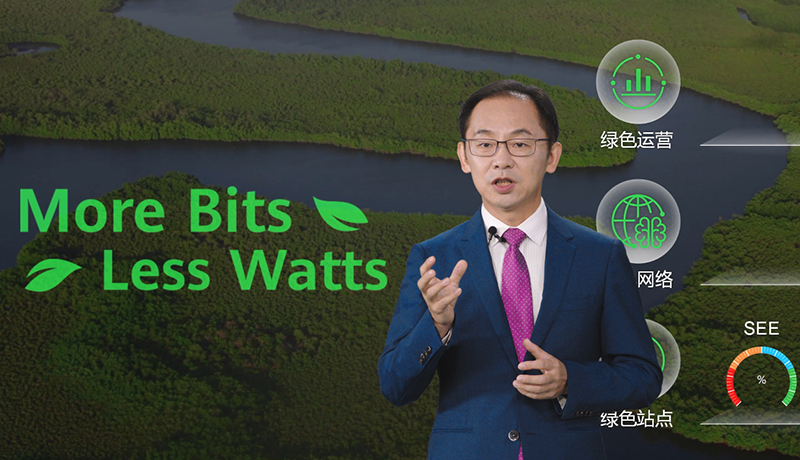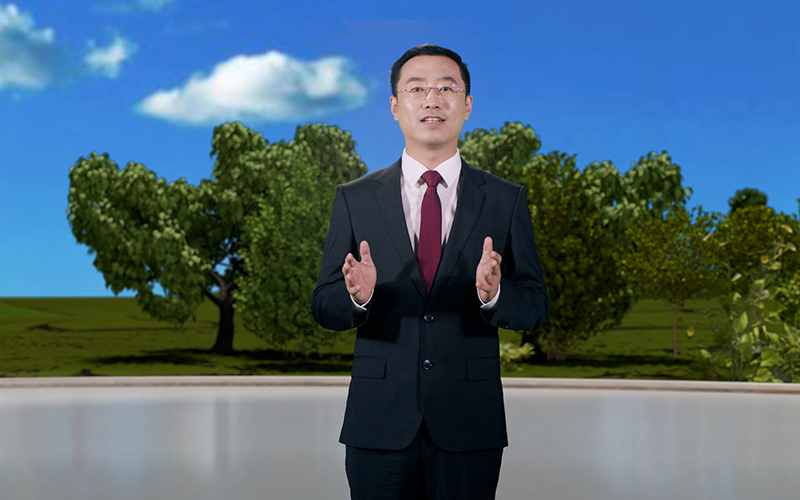
At Huawei Win-Win Innovation Week, executives Ryan Ding, President of Huawei’s Carrier Business Group, and Dr. Philip Song, Chief Marketing Officer of Huawei’s Carrier Business Group, discussed the role of sustainable ICT infrastructure in assisting operators in systematically building green networks to address traffic growth while also supporting carbon emission reduction.
This occurred on the second day of the event, during the Green Development Solutions Launch, which was followed by the launch of a new solution suite.
Green ICT for New Value
Ryan Ding, in his keynote speech titled “Green ICT for New Value,” emphasized the importance of operators prioritizing energy efficiency and called for the creation of a standard, industry-wide indicator system for energy efficiency.
He explained, “Every major advancement in history has been accompanied by a significant improvement in the energy efficiency of information transmission. The increase in carbon emissions generated by exploding data traffic will become a global problem that must be tackled in the next five to ten years. Increasing energy efficiency will be the way forward.”
Third-party research predicts that data traffic generated by digital services will more than triple from 2020 to 2030. This means that if energy efficiency improvements are not implemented, the ICT industry’s energy consumption and carbon emissions will increase by a factor of 2.3. According to ITU, the ICT industry will need to reduce carbon
emissions by at least 45 percent by 2030 in order to meet the Paris Agreement goal set by the United Nations Framework Convention on Climate Change (UNFCCC).
Ding said, “We are now facing an unprecedented challenge: As more and more industries are going digital, the demand for data will rise sharply, which will result in a surge in energy consumption. In the meantime, the whole world is working to combat climate change, and the ICT industry must urgently achieve carbon peak and carbon neutrality.”
Energy efficiency improvements will benefit operators in three ways. First, user migration, site upgrades, and reduced network power will result in OPEX savings. Second, greater energy efficiency will facilitate the transition of 2G and 3G users to 4G and 5G services. Third, the efforts of operators to reduce their carbon footprint will benefit the environment, allowing them to better fulfill their social responsibilities.
Huawei has proposed a three-tiered solution to assist operators in meeting these objectives: green sites, green networks, and green operations. First, Huawei developed solutions to improve site energy efficiency through the use of a highly integrated design, new materials, and the relocation of main equipment and power supply units outside. Second, the company’s simplified network architecture speeds up forwarding and allows for the development of simplified, all-optical, and intelligent networks. Finally, Huawei provides an operations solution that generates and distributes optimization policies while making energy efficiency more visible and manageable.
These green development solutions have been deployed for operators in over 100 countries so far. In Germany, for example, Huawei’s PowerStar solution has enabled minute-level energy efficiency self-optimization, significantly improving energy efficiency. Huawei’s optical cross-connect (OXC) solution was deployed on a customer’s backbone network in Spain, increasing energy efficiency by 81% and
lowering costs by 29%. Huawei has deployed its green site solution for a customer in Turkey, where equipment rooms are replaced with cabinets, removing the need for equipment rooms and air conditioners. It is expected that the solution will save 19,000 kWh of electricity per site per year.
Huawei and its operator partners are already working together to increase their “carbon handprint” by empowering carbon-intensive industries to boost energy efficiency using ICT solutions. The emissions reduction they enable can be 10 times their own emissions. Many success stories have already been seen in key carbon-intensive industries like ports, coal mining, and steel.
At the end of his speech, Ding called on the establishment of a unified, industry-wide indicator system as this would help establish baselines against which energy efficiency can be measured and serve as a guide for the green development of the ICT industry as a whole. Ding closed out his speech saying, “Huawei is ready to work with operators and create new value with green ICT.”
Launching Green Infrastructure Solutions

Dr. Philip Song announced the launch of a new suite of green development solution, and delivered a speech titled “Developing Green ICT Infrastructure with Optimal Energy Efficiency”. He explained how the solution is aimed at helping operators systematically improve network energy efficiency: “As ICT infrastructure continues to evolve from 5G and F5G to 5.5G and F5.5G, green networks, evaluated against the network carbon intensity (NCIe) index, will become a critical part of future target networks. The main objective of our solution launch today is to help operators systematically build green networks that simultaneously address traffic growth and carbon emission reduction.”
According to Song, technological innovation is required at three levels to help customers achieve green development goals:
· At the site and equipment level, more integrated designs and new materials should be used to move sites fully outdoors, and increase equipment energy efficiency and the efficiency of using renewable energy.
· In cross-site coordination and networking, a simplified network architecture and improved forwarding efficiency are required to maximize energy efficiency and make networks all-optical, simplified, and intelligent.
· To achieve green O&M, new O&M and energy-saving policies should be more easily developed and delivered, and energy efficiency indicators and baselines should be made more visible, manageable, and optimizable.
At the event, Song launched Huawei’s green development solution with innovations at these three levels, as well as the new NCIe indicator system which supports this three-layer solution of green sites, green networks, and green operations. The NCIe energy efficiency indicator system proposed by Huawei has been approved by ITU-T SG5 and is now in the process of public consultation.
Closing out his speech, Song also announced the opening of the Evergreen Land engagement room, where Huawei will meet with global operators to discuss in-depth about green development and ways to build the most energy-efficient ICT infrastructure. He reiterated, “Huawei is committed to working with operators to improve the energy efficiency of ICT infrastructure and create value using green ICT technologies.”